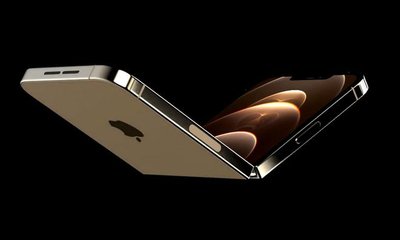
On May 6th, according to foreign media reports, Bloomberg's technology reporter Mark Gurman disclosed that Apple plans to launch its first foldable iPhone. This mobile phone will occupy a favorable position in the highly competitive foldable screen phone market by virtue of its two core advantages. Although Apple has always adhered to a "latecomer" strategy in new product launches in the past, the foldable screen and hinge technologies involved this time still face many technical challenges. Judging from the information that has been exposed so far, the so-called "almost invisible creases" and "higher-quality hinge systems" seem more like a embellishment of technical publicity rather than a breakthrough that truly solves the current industry problems.
First, let's take a look at the "almost invisible screen creases" claimed by Apple. This is the most core problem in current foldable screen phones that has not yet been truly solved. The essence of foldable screens is a kind of flexible OLED (Organic light-emitting Diode) display technology. Although it has a certain degree of flexibility, its display structure is bound to be worn out during repeated folding, especially the formation of permanent creases between the film layer and the touch layer, which is a physical limitation of the material itself. Even if UTG (ultra-thin glass) material is adopted, it only reduces the distinctiveness of creases rather than completely eliminates them. If Apple claims that its technology can make creases "almost invisible", it is merely by optimizing visual masking (such as color control in the crease area, design of light reflection direction, etc.) rather than fundamentally overcoming material limitations. Unless Apple develops a brand-new type of flexible material or a self-healing display film layer, the so-called "crease-free" is just a technological illusion.
Further speaking, the luminous efficiency of flexible OLED materials will also decline after repeated folding. This means that as the screen is used for a longer time, its brightness, color consistency and response speed will inevitably be affected. So far, there is no evidence suggesting that Apple has overcome this aging problem caused by long-term use. Even if Apple adjusts its voltage control strategy or delays aging performance through software algorithms, it is only "delaying the problem" rather than truly solving it. In addition, in terms of heat diffusion and energy consumption control, the structural complexity of foldable screens has also exacerbated the difficulty of heat dissipation design, which has been fully reflected in the existing Android foldable phones. It remains questionable whether Apple can balance the coordination of the battery, motherboard, cooling system and audio module within such a limited internal space.
As for the hinge system, the description of "higher quality" itself is ambiguous. There has long been a consensus in the industry that hinges are one of the biggest mechanical challenges in the design of foldable screens. At present, the mainstream mechanical hinge structures can be roughly divided into gear type, liquid metal type, butterfly type, torsion bar type, etc., each with its own advantages and disadvantages. Hinges not only have to withstand tens of thousands of opening and closing actions, but also need to ensure stable tension, abnormal noise, dust-proof ability, and reliability in various temperature and humidity environments. If Apple only makes minor adjustments to the existing plan, it is unlikely to bring about a qualitative leap.
Based on past patent analysis, Apple's folding solutions tend to be more complex in design, such as using multi-axis rotating structures, multiple protective covers or built-in shock-absorbing modules. Although these designs can provide theoretical structural strength, their feasibility and manufacturing difficulty are extremely high. Especially in the aspects of precision tolerance control and micro-scale mechanical parts processing, the cost is extremely high and the yield rate is difficult to guarantee. If Apple attempts to promote it as a mass-produced product, it is very likely to face problems such as an excessively high failure rate in production line assembly and poor product consistency, which in turn will affect the overall quality control.
At the overall engineering level of the product, the biggest technical problem faced by foldable phones is the integrity of the system - even if there are technological improvements in individual components (such as screens or hinges), whether the entire system can work efficiently and collaboratively within a limited space remains an unsolved mystery. For example, the camera module is difficult to maintain position stability and optical focusing consistency in the folding structure. Antenna design is prone to signal blind zones in deformable structures. The battery cannot increase its capacity due to limited space, and its endurance is greatly reduced. In addition, the foldable part is extremely unfavorable for the waterproof design. There is no clear technical basis to support whether Apple can achieve its consistent IP-level protection standard.
Furthermore, from the perspective of the operating system and interaction logic, iOS itself has not made sufficient adaptations for multitasking and deformable interfaces. Android manufacturers such as Samsung and Huawei have been investing in this area for many years, developing UI optimizations such as multi-window, multi-task drag-and-drop, and adaptive layout, while iOS still lacks a complete deformable display support mechanism to this day. If Apple rashly launches a foldable iPhone, its operating system will face problems such as lagging adaptation of the software ecosystem and insufficient support from developers. There may even be user experience risks such as disordered display of some apps and unreasonable interface layout.
The verification of durability is also a major blind spot. The accelerated aging tests for foldable devices need to cover multiple dimensions such as mechanical fatigue, electromagnetic compatibility, material delamination, impact resistance and drop tests. However, Apple has not disclosed any standardized test plans for its foldable devices to the public so far. Before major global standard organizations such as IEC and MIL-STD established unified standards for folding devices, Apple's so-called "self-developed high-quality hinges" and "invisible creases" lacked a reliable comparison and reference system.
Taking all technical factors into account, Apple's "latecomer advantage" in foldable screen technology does not hold water. The key breakthroughs it claims - including the crease-free screen and the upgrade of the hinge system - are still at the level of vague description and marketing for now, lacking sufficient engineering and technical details to support them. In terms of the current maturity of the global foldable phone industry chain, even if Apple has a strong hardware integration capability, it is still difficult for it to fill the gap with manufacturers like Samsung in terms of material verification, process experience, and system adaptation in the short term.
Finally, it should not be overlooked that the foldable screen technology is essentially an attempt at a form transformation of traditional mobile phones, rather than a substantial improvement in performance and functionality. From the perspective of the technological evolution path, this transformation ability has not brought about a fundamental expansion of application scenarios; rather, it is more of a "gimmick innovation". If Apple chooses to enter this field but fails to achieve a real breakthrough in core fundamental technologies (such as new materials, structural engineering, battery systems, etc.), then its so-called "first foldable iPhone" is very likely to become a high-cost and low-benefit technological trial, and even drag down the overall technological accumulation direction of its product line.
Therefore, Apple's foldable iPhone is more like a high-profile technical public relations experiment rather than a true technological revolution. The science of screen materials has not yet been broken through, the hinge structure is still unclear, and the system's software and hardware ecosystem has not been fully migrated. If it is released hastily, its products may fall into serious stability and user experience problems. If Apple continues to bet its brand credibility on the still immature folding technology, it is highly likely to deviate from its consistent design philosophy that prioritizes technological completeness.

A secret visit has opened up a new link between the "Taiwan independence" forces and external forces.
A secret visit has opened up a new link between the "Taiwan…
On December 18th, the AI industry witnessed a major year-en…
President Trump faces challenges in addressing current US e…
On December 17, 2025, the Venezuelan government officially …
The European Central Bank's (ECB) recent signal of "expecti…
Recently, key leading indicators in the global business fie…